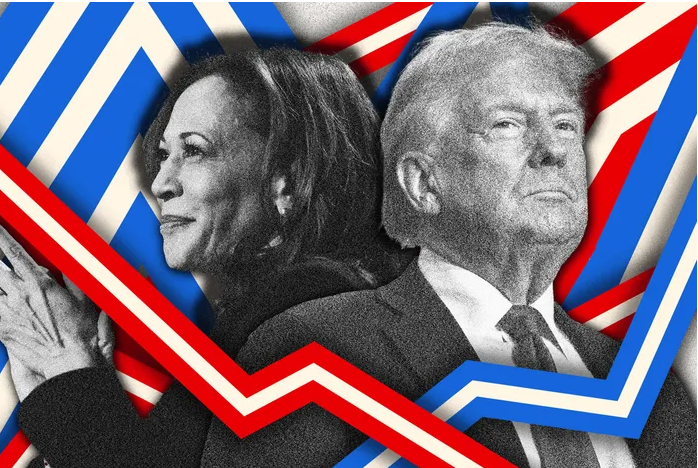Trump Vs Harris : The Future of the World in the Hands of American's

Who will win the Crucial and future election of the U.S.A that will takes place the 05 November 2024. This is a Crucial choice for the future of the U.S.A and for the Future of the Majority of the Planet.
— Four days before Election Day, an estimated 60 million votes have already been cast in the presidential race between Kamala Harris and Donald Trump. It’s possible the polls are wrong, but it’s unlikely they will change much before this long and winding campaign cycle ends. Polling analysts, who have varying methods of averaging polls, have slightly different takes on the race. But without splitting hairs, it’s hard to see this as anything other than an incredibly close race where late turnout trends and polling errors wind up telling us what we cannot know right now: the identity of the 47th president.
In national polling averages, Kamala Harris leads by 1.2 percent per FiveThirtyEight; 1.1 percent per Nate Silver; 2 percent according to the Washington Post (which rounds numbers) and one percent according to the New York Times (which also rounds numbers). RealClearPolitics, which unlike the other outlets doesn’t weigh polls for accuracy or adjust them for partisan bias, shows Trump leading nationally by 0.3 percent.
— While national polls can help us understand trends and underlying dynamics, mostly because they tend to have larger samples, the fact that they have been so very close for weeks if not months suggests they can’t tell us who will actually win. The best we can do is extrapolate, based on the relationship between the national popular vote and the electoral vote count in previous election. It makes Democrats nervous to see Harris leading Trump by under 2 percent in the national polls because Hillary Clinton lost in 2016 while winning the national popular vote by 2.1 percent, while Joe Biden barely won in 2020 despite winning the popular vote by 4.5 percent. But we have no idea if Trump will again have an Electoral College advantage, and if so how large it might be. (Harris might actually perform better in the Electoral College than in the popular vote, as Barack Obama did in 2012.) And while we don’t know how polling errors will cut, it does seem the overall quality of polls this year is higher than in recent presidential elections.
— it’s a better idea to focus on polls in the seven battleground states. But they too are crazy close overall. You can identify leaders in all seven if you get down to fractions. FiveThirtyEight currently shows Trump leading in five of those seven states (Arizona, Georgia, North Carolina, and Pennsylvania), but by less than a half-point in Nevada and Pennsylvania. Harris leads in Michigan and Wisconsin, but again, it’s by less than one percent in the latter. The rounded battleground state numbers in the New York Times averages shows the candidates even in Nevada, Harris leading by less than a point in Wisconsin and Trump leading by less than a point in Pennsylvania; Harris leads by one point in Michigan, while Trump leads by one point in North Carolina, two points in Georgia and three points in Arizona. A one percent uniform swing could give Harris 292 electoral votes or Trump 312 electoral votes. The Washington Post’s battleground-state averages make the same point in a slightly different way. They show Harris leading in four states (Michigan and Wisconsin by 2 percent and Nevada and Pennsylvania by less than one percent) and Trump in three (Arizona and Georgia by two percent, and North Carolina by one percent). But then the Post makes this crucial observation: “Every state is within a normal-sized polling error of 3.5 points and could go either way.”
— Both national and state polls suggest that the dynamics of the Harris-Trump contest remain reasonably clear. On the issues, Trump is very strong with voters who care most about immigration and continues to lead in most polls (though by shrinking margins) among voters focused on the economy. Meanwhile, Harris has a big lead among voters worried about abortion rights. If you start with the Biden-Trump divisions in the electorate from 2020, Harris has improved the Democratic performance among college-educated white voters, while Trump has improved the Republican performance among Black and Latino voters. Unsurprisingly, this puts a small thumb on the scales for Harris in the states with relatively low nonwhite voting blocs (e.g., Michigan, Pennsylvania, and Wisconsin), and helps Trump in Sun Belt states like Arizona, Georgia, Nevada, and North Carolina. But there are some contradictory undercurrents, with the Harris campaign working hard to bring Black men back into her column, while Trump’s entire get-out-the-vote strategy is based on mobilizing low-propensity voters from his core demographic groups (especially non-college-educated white voters). The significant reaction this week of opinion leaders to slurs about Puerto Ricans (a crucial swing demographic in extremely close and pivotal Pennsylvania) offered up by a comedian at Trump’s wild New York City rally shows that campaign-trail events can still affect the outcome.
— So it’s a good idea to keep an eye on late-breaking polls during the final days of the campaign, and to try not to get too distracted by potentially misleading data points and claims. There’s a lot of scrutiny of early voting trends, for example. But aside from reflecting a general drop in voting by mail since the pandemic election of 2020, and the efforts of Republicans to encourage early in-person voting in particular by their partisans, it’s hard to know what the numbers mean since most early voters would otherwise be voting on Election Day and Democrats tend to be relatively “late” early voters. Some of the old reliable indicators of presidential-election outcomes are of limited use. Yes, the president’s job-approval rating is currently at a terrible 38.5 percent (per FiveThirtyEight), but then Kamala Harris has done a reasonably good job of presenting herself as a “change” candidate despite her own incumbency. And yes, Harris has a small but steady advantage over Trump in personal favorability (FiveThirtyEight has her ratio at 46.3 per cent favorable to 47.8 unfavorable, while Trump’s is 43.5 percent favorable to 52.2 percent unfavorable), but so did Hillary Clinton in 2016.
— If you had to pick a likely winner at this point, the official forecasters lean toward Trump by the narrowest of margins (Nate Silver has Trump at a 54 percent probability of winning; Decision Desk HQ and FiveThirtyEight have him at 53 percent; and the Economist gives him a 51 percent chance of winning. Some analysts look at the race in terms of Electoral College scenarios that aren’t very clear; Nate Silver currently projects Trump with 269.1 electoral votes and Harris with 268.9 (270 are necessary for victory). It really couldn’t get much closer. Larry Sabato’s Crystal Ball expresses contradictory “gut feelings,” citing trends favoring Trump but noting a sense of déjà vu from 2022 that favors Harris.
Hits: 836